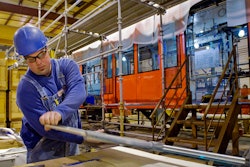
Falcon Electric, Inc.
The Growth of IoT/IIoT
and the Need for Industrial UPS Systems
Introduction
Engineering Department
Falcon Electric, Inc.
www.FalconUPS.com
©2017 Falcon Electric, Inc.
All Rights Reserved
2
Today, self-driving cars, automated toll booth roadways, ATM
machines, smartphones, and industrial automation are
changing your way of life. The Internet of yesterday was
computers connected to each other. Now, mobile devices
have multiplied Internet usage and soon connected machines
will outnumber computers and smartphones. This network of
today’s Internet of Things (IoT) and Industrial Internet of
Things (IIoT) must operate continuously and reliably. Incorporating online industrial-grade
uninterruptible power supplies (UPSs) will ensure continual network operations when electrical
power is compromised.
The Significant Difference Between IoT and IIoT:
IoT (Internet of Things) is the technology that you touch daily. Your refrigerator, oven, security
system and heating/cooling system will be part of the Internet of Things as they become smarter
and communicate with you via your smartphone or other devices.
IIoT (Industrial Internet of Things) is the largely unseen operation of data centers,
manufacturing facilities, water treatment, electricity, gas (both heating and automotive), oil and
gas fields, emergency dispatch, as well as automotive, railway, and airplane control systems.
These critical systems differ from the IoT as they must operate in industrial environments that
are subject to power problems, heat, dust, moisture and physical movement or impact. In other
words, IIoT is rugged or industrialized by design.
Automated Process and Reliability Challenges
In industrial plants, distributed treatment processes are
controlled by IIoT and will replace legacy Supervisory
Control and Data Acquisition (SCADA), Programmable
Logic Controllers (PLCs) and other systems. IIoT will
control the pumps, valves, meters, cameras, water
sampling and other vital processes that are distributed
throughout the treatment facility. In addition, IIoT can
aggregate the data to control operations locally, remotely
or automatically.
3
The Role of Uninterruptible Power Supplies (UPSs)
IIoT, as well as SCADA and PLCs, require steady, clean, reliable power. Due to the presence
of motors, pumps, utility grid switching, lightning and other factors, IIoT devices often encounter
polluted power that causes errors in the measurement of sensors and operational functions.
UPS products are required to provide reliable, regulated power to IoT or IIoT systems and
protect against common utility power problems, including outages. During an outage, the UPS
will transition to battery backup operation to continuously protect these systems.
UPSs: Office and IT-Grade vs. Online Industrial-Grade
Office and IT-grade UPS products are widely available in the UPS market and include common
design parameters that offer limited to good protection in controlled environments. Industrial-
grade UPS products are specifically designed to withstand the rigors of non-controlled, industrial
environments.
Office and IT-Grade UPS:
Office and IT-grade UPS products are designed to protect computers and other electronic
devices in a temperature-controlled environment. They are designed for the temperature range
of an office or home 0°C to 40°C (32°F to 104° F) and will provide battery backup during a power
outage to safely shut down connected loads. Office and IT-grade UPSs are not designed for
industrial applications since they cannot withstand environmental conditions such as high
temperature. If these units are used in such unforgiving settings, unscheduled maintenance and
frequent battery replacements will be necessary – increasing operational costs.
Online, Industrial-Grade UPS Systems Go the Distance:
Online, industrial-grade UPS products are specifically designed for industrial environments. All
plastics, batteries and electronics are built with high-grade components that are rated to operate
in wide temperatures. Moreover, for harsh environments, an industrial UPS may add conformal-
coated printed circuit boards in order to protect the circuits from moisture or chemical
contaminants.
4
The following are important features and options of online industrial UPSs:
1) Rugged Design and Wide Operating Temperature
Double-conversion online industrial UPSs
feature a wide operating temperature range of -
20°C to 55°C (-4°F to 131°F), or an ultra-wide
range of -30°C to 65°C (-22°F to 149°F), that
are necessary in outdoor and/or high-
temperature installations. It is vital that the
electronics, plastics and batteries are agency
certified (UL, cUL, CE) to operate in this
temperature range. The higher-grade components
used in the UPS’s critical circuitry, assure reliable operation over the wide temperature range.
Internal cooling and battery thermal insulation are also more efficient in the industrial-grade
UPS. Installing a low-cost, office-grade UPS that is only rated to operate in modest temperature-
controlled environments is not recommended.
2) Wide-temperature Batteries and Extended Battery Runtimes
Prolonged exposure to high temperature significantly reduces a battery’s overall service life.
Falcon’s industrial-grade UPS with next-generation, 10 to 12-year batteries enable these units
to perform in high and low temperatures. The batteries have a superior 10 to12-year rated life in
a 25°C (77°F) environment. When exposed to a 50°C (122°F) environment, they have a 4-year
service life.
Furthermore, only industrial UPSs like Falcon’s are capable of extending battery backup times
from a couple of minutes to several hours. The extended backup time allows industrial
applications to continue operating critical loads during prolonged power outages. Falcon offers
extended battery modules that include 40 Amp-per-Hour batteries allowing several hours of
backup time.
3) Agency Safety Certifications: UL 1778 and UL 508
It is critical that the UPS is safety agency-certified (UL, cUL, CE) to
operate within the specified operational temperature range. UL 508 is
a requirement for UPS systems installed in an industrial control panel
for the majority of applications. Beware of UPS products that are not
5
safety agency certified. If they are not, code inspectors may require the UPS units to be
removed from the control panel.
4) NEMA 3R and 4-Rated Enclosures
A weather protected environment is key to the reliability of most electronic equipment. Falcon
offers systems pre-packaged inside NEMA 3R enclosures as well as in environmentally
controlled (air conditioned) NEMA 4-rated enclosures. Falcon’s UPS solutions are a cost-
effective solution for wide-temperature environments where continual power conditioning and
reliable backup power are required.
5) Communications Options
Falcon’s UPS systems offer communication options, such as an SNMP/HTTP agent. This allows
for remote UPS monitoring and management via 10/100BaseT, GSM/GPRS Cellular, 802.11G
and RS-232/RS-422/RS-485. Dry contact relay cards are also available.
Conclusion
As the world of IoT and IIoT expands, there is an increasing requirement for 24-hour power
protection that can withstand the rigors of industrial power environments. All UPSs are not
created equal—having the right tool for the right job is crucial. Only a double-conversion, online
industrial UPS will increase system reliability while reducing maintenance expenses.
©2017 Falcon Electric, Inc. All rights reserved. Falcon Electric, Inc. Proprietary
Proprietary:
The information contained herein is proprietary to Falcon Electric, Inc. and shall not be reproduced or disclosed
in whole or in part or used for any reason except when such user possesses direct, written authorization from
Falcon Electric, Inc.
The statements contained herein are based on good faith assumptions and provided for general information
purposes only. These statements do not constitute an offer, promise, warranty or guarantee of performance.
Actual results may vary depending on certain events or conditions. This document should not be used or relied
upon for any purpose other than that intended by Falcon Electric, Inc.






















